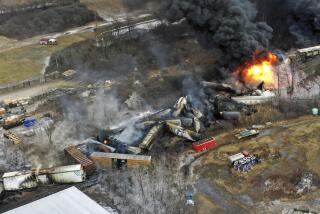Cause of USAir Crash Still Lost in the Wreckage : Aviation: NTSB is about to hold hearing to compare notes on September disaster that killed 132. Many think a solution will never be divined.
Usually by now in the investigation of a plane crash, the National Transportation Safety Board has come up with something telling.
It may be a readout from a “black box” recorder that provides crucial information on an airliner’s last seconds of flight, or an important clue gleaned from a large chunk of wreckage, or detailed testimony from a survivor, or conclusions that can be drawn from an earlier, similar crash.
That hasn’t happened in the case of the Sept. 28 crash of USAir Flight 427.
The Boeing 737 jetliner rolled suddenly to the left and plunged 5,000 feet to the ground as it approached Pittsburgh International Airport in Pennsylvania, killing all 132 people aboard. As federal investigators convene a weeklong hearing in Pittsburgh on Monday, they have little progress to report.
The flight data recorder recovered from the wreckage was an older model that provided only 17 channels of information on the plane’s performance, compared to about 100 available on the more modern recorder recovered from the wreckage of a commuter plane in Indiana last Halloween.
Slamming nose first into the ground at more than 300 m.p.h., the 737 shattered, leaving investigators few pieces big enough to provide meaningful information.
No one survived the accident, and because the jetliner crashed near dusk in a rural area, there were few witnesses on the ground.
The only apparently similar accident was the crash of a United Airlines 737 in Colorado Springs, Colo., in 1991, and the cause of that one remains a mystery too.
What it all means is that this time the principal objective of the hearing will be to question experts in the hope that the exchange of information, ideas and theories will produce something new.
“We hope to get detailed factual information in areas in which we haven’t had information before,” said Mike Benson, an NTSB spokesman. “We’ll be talking to Boeing, USAir, NASA, the FAA--people who have played a role in developing the 737 and its components . . . people who have flown the plane.”
When it comes to the big question--why did Flight 427 crash?--the NTSB hasn’t ruled out anything yet, but the theories thus far have failed to prove out.
The possibility of a bomb--suggested because Flight 427 carried an FBI informant--was cast aside after investigators failed to find any evidence of an explosive.
Suggestions that one of the plane’s two engines may have reversed also failed to pan out.
Passengers on an earlier leg of Flight 427 said they heard strange noises. The “whooshing sounds” were eventually traced to an open microphone on the plane’s public-address system.
Other theories remain viable but unproved.
Aviation experts have noted that a sudden, full deflection of the rudder--the large, hinged slab on the vertical part of the tail that helps a plane turn left or right by pushing the tail in the opposite direction--could have caused Flight 427’s sudden roll to the right and nose-ward plunge.
The rudder was suspect in the Colorado Springs crash, and exhaustive tests have been performed in an effort to learn whether Flight 427’s rudder systems performed properly. Thus far, nothing conclusive has been found.
Investigators determined that the hydraulic fluid in the rudder-control systems was contaminated but that it had nothing to do with the crash. The NTSB said Flight 427 may have encountered wake turbulence from a plane four miles away. While some have theorized that this swirling wake may have upset Flight 427, others say that is unlikely, considering the size and weight of the Boeing 737.
Sources close to the investigation suggest that if a cause is determined, it probably will include a combination of these factors, perhaps exacerbated by the cockpit crew’s reactions.
There are many--among them Barry Schiff, a veteran airline pilot and consultant on crash investigations--who think there are too many missing pieces, that the cause will never be known.
Others--like Benson and Carl Vogt, the NTSB member who headed up the current investigation until his retirement Jan. 1--say they believe that investigators will master the puzzle.
“We don’t have as many leads as in other investigations,” Benson said. “We’ll have to do some extrapolation. But in the end, yes, we will solve it.”
More to Read
Sign up for Essential California
The most important California stories and recommendations in your inbox every morning.
You may occasionally receive promotional content from the Los Angeles Times.










